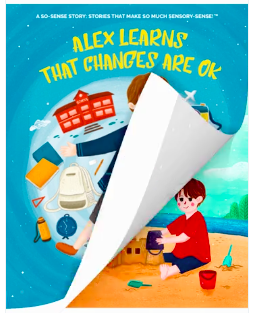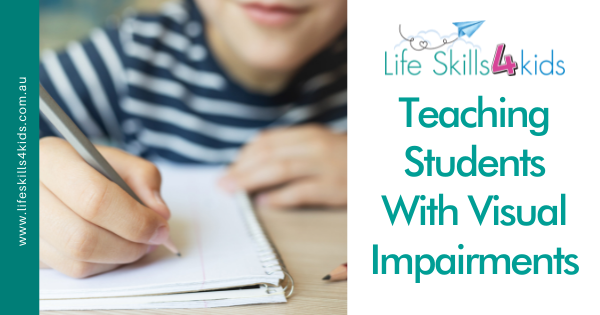In your classroom group, there will be a wide range of abilities and needs for individual pupils. It is important to devise strategies to enable each individual to have the greatest access possible to your daily activities and lessons.
The chances are that you will not be a specialist teacher of students with visual impairments (VI). Have a look at the following strategies to give you ideas and suggestions for how to make your classroom and your teaching as VI friendly as possible.
Here’s a great quote from Stevie Wonder to get you thinking:
“Just because a man lacks the use of his eyes, doesn’t mean he lacks vision.”
A Quick Assessment for Teaching Students With Visual Impairments
When you have a young person with VI in your classroom, the first thing to do is work out what they can see. As you are aware, there are many different levels of VI and it’s really important to find out, on an individual basis, what level of sight a child has access to.
REMEMBER – do not embarrass your student by singling them out – this could cause extra anxiety issues which will have a very negative impact on the help you want to provide. If you can, encourage a friend to be the “Learning Champion” who can help your student with VI to access activities.
Alternatively, build up a “Circle of Friends” support team around your VI student – that way they have peer support and their peers will learn some great lessons in being a part of an inclusive community.
Assessing a pupil’s level of sight is key in teaching students with visual impairments.
Here are some questions to keep in mind during a quick initial assessment:
- Do some simple tracking activities:
- Can your student track left to right/right to left?
- Can they track up and down/down and up?
- At what point do they lose sight of the object if you move it forwards in a straight line?
- When do they lose sight of the object if you move it forwards to the right/forwards to the left?
- Use this information to work out where the student will sit in the classroom for best access to whiteboard work
- During group work at the table:
- How close do they need a book to be able to see it?
- What size do pictures need to be for them to access them?
- What are the best colour for backgrounds and print?
The answers to these questions should give you a good idea of how to tailor your teaching to help your student(s) with VI. If the provision is available, the ideal scenario is to refer to a specialist VI Teacher who will be able to provide an in-depth assessment and individualised strategies for each student.
Strategies for Teaching Students With Visual Impairments
Lighting
- Depending on a student’s needs, they may need additional lighting or reduced lighting
- The ideal situation is for light to be distributed equally onto the activity they are working on – so that there are no shadows or extra glare thrown back into the student’s face
- If it’s possible, use blinds/shades on windows to reduce glare from outside
- Cover shiny tabletops, avoid shiny pages and shiny blackboards – aim for light-absorbing materials which reduce any glare or shine.
Specialist Support
- We mentioned this earlier – as a professional, you should have access to a specialist VI teacher who will be able to provide you with expert assessments, valuable strategies and extra resources.
- A specialist VI teacher may also be able to provide some of their time for 1:1 or small group sessions for your VI students.
- A VI teacher will also be able to provide a braille machine if required, braille books and potentially mobility training for your VI student. (It is easy for us to forget that many pupils with VI will struggle to navigate both around the classroom and school environment. They may need support with learning how to use a white stick or even becoming familiar with a guide dog).
Delivery of Information
As a classroom teacher, there are strategies to keep in mind which will help your VI students.
- Have you allowed enough space around them for your student to use the extra resources they may require?
- Is your student next to an easily accessible power source if they are utilising ICT to help them learn?
- Is the “classroom map” clean, tidy, clutter-free and VI friendly?
- Does the “classroom map” include tactile and auditory clues?
- If your student has a high level of VI, you could think about having a raised/textured strip around all of the edges of furniture in the classroom.
- All resources that the VI students need to access should always be in the same place, well-labelled and with textured clues to be able to find them
- Some VI students will need yellow acetate over their work to help them focus on the print
- Think about the font that you use, it should be clear and uniform
- Contrast is important too – VI students tend to have greater success accessing white or yellow print on a black background
- Keep pictures simple and experiment with different sizes with your VI students. Again, think about contrast (see above) and also think about simple, very obvious, line drawings
- Does you student need talking books? Have a look at sites like Vision Australia for accessing books for your VI students
Considerations for Outside The Classroom
It is easy to just work really hard on making your classroom a safe, accessible place for all of your VI students. Remember though, that teaching students with visual impairments does not stop there, they will also have to access the rest of the school, both the inside and the outside.
Be prepared, before issues start to arise, plan how to make dinner time, play time and school arrival/leaving time as accessible as possible.
It may be a good idea to allow VI students and their buddy or buddies to leave for a venue 5 or 10 minutes early, to give them time to settle before the general chaos ensues!
As a whole school, there are always some great projects to get into – ones that will help all students, including those with VI and other special needs. For example, you could build a sensory garden in the school grounds or challenge the students to find and design games that everyone can play.
At LifeSkills4Kids, we have some great articles to help you make your classroom into a more sensory one:
- Get the whole class involved with these ideas
- Watch this video to assess how sensory-friendly your classroom is
- Find a checklist for a sensory school environment
- Start by detoxing your classroom
ALEX LEARNS FLIPBOOK
Alex loves school. He enjoys all the activities he does during the term such as swimming and soccer. He also loves holidays and all the fun things he gets to do while he’s not at school. The problem is, Alex doesn’t like changes. His tummy gets all tight and he gets a worry cloud that comes over his brain and makes it feel foggy. When the school term ends and holidays begin or when school is about to start again, Alex feels really worried and anxious.
When you purchase the Alex Learns that Changes are OK (Flipbook), you will receive a digital flipbook that gradually changes from one page to the next while listening to high-quality audio narration as if someone is flipping and reading the book for you!


